LAW 6000 Business Law: Analyzing Partnership Liability & Consumer Law
VerifiedAdded on 2023/05/30
|8
|1856
|428
Case Study
AI Summary
This assignment presents a comprehensive analysis of three distinct business law case studies. The first case examines partnership liability, determining whether a partnership can be held liable for the actions of one partner and exploring legal remedies for other partners. It applies principles from the Partnership Act 1892 and relevant case law, such as Polkinghorne v Holland. The second case focuses on consumer rights and contract law, assessing the legality of a contract formed under potentially unconscionable conduct and addressing false advertising claims under the Australian Consumer Law. It references the Competition and Consumer Act 2010 and the Commercial Bank of Australia v Amadio case. The final case explores the principle of promissory estoppel, evaluating whether a promise made outside a formal contract is enforceable, referencing cases like Combe v Combe and Ajayi v Briscoe. The analysis concludes with clear determinations of liability and available legal remedies in each scenario.
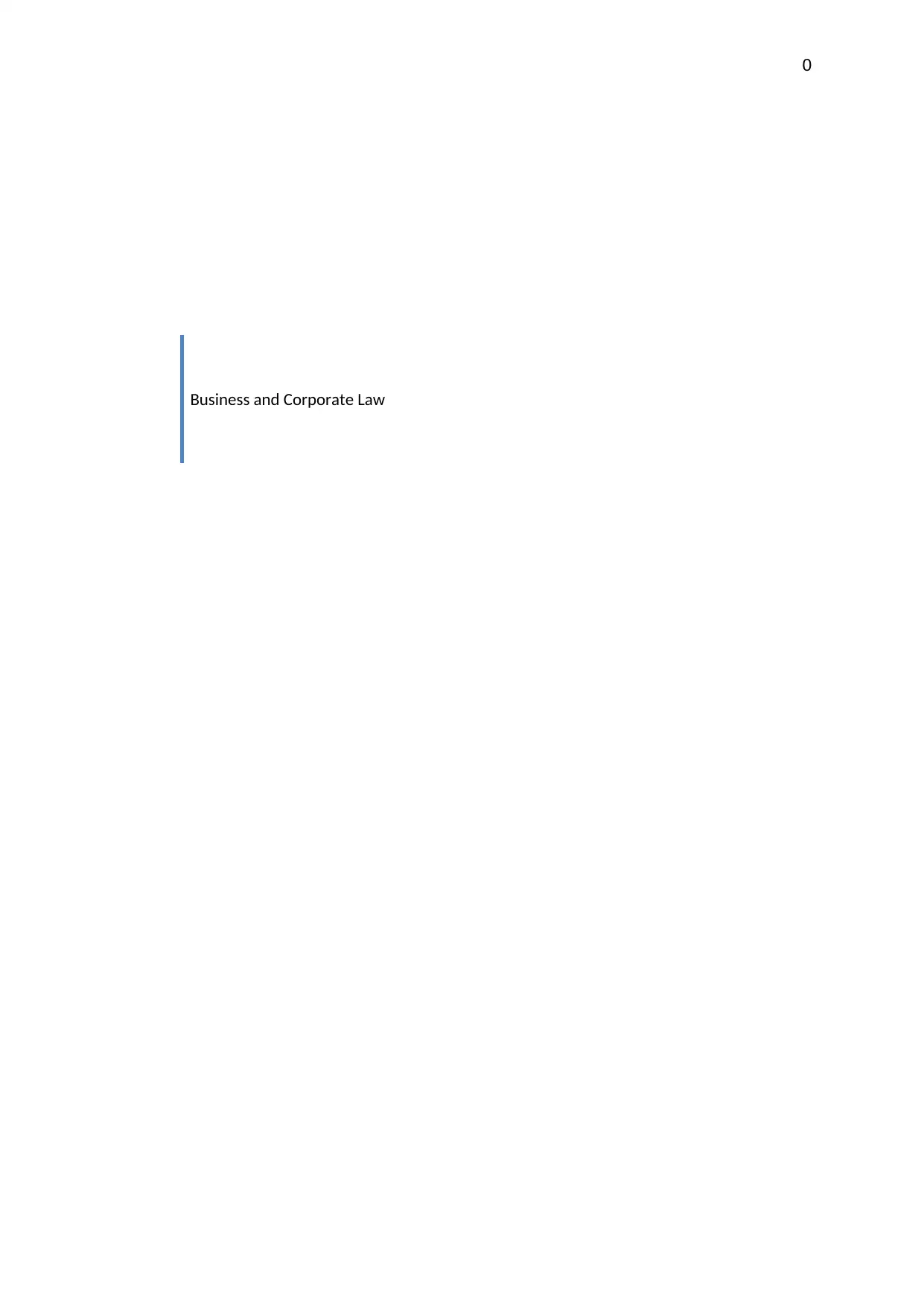
0
Business and Corporate Law
Business and Corporate Law
Paraphrase This Document
Need a fresh take? Get an instant paraphrase of this document with our AI Paraphraser
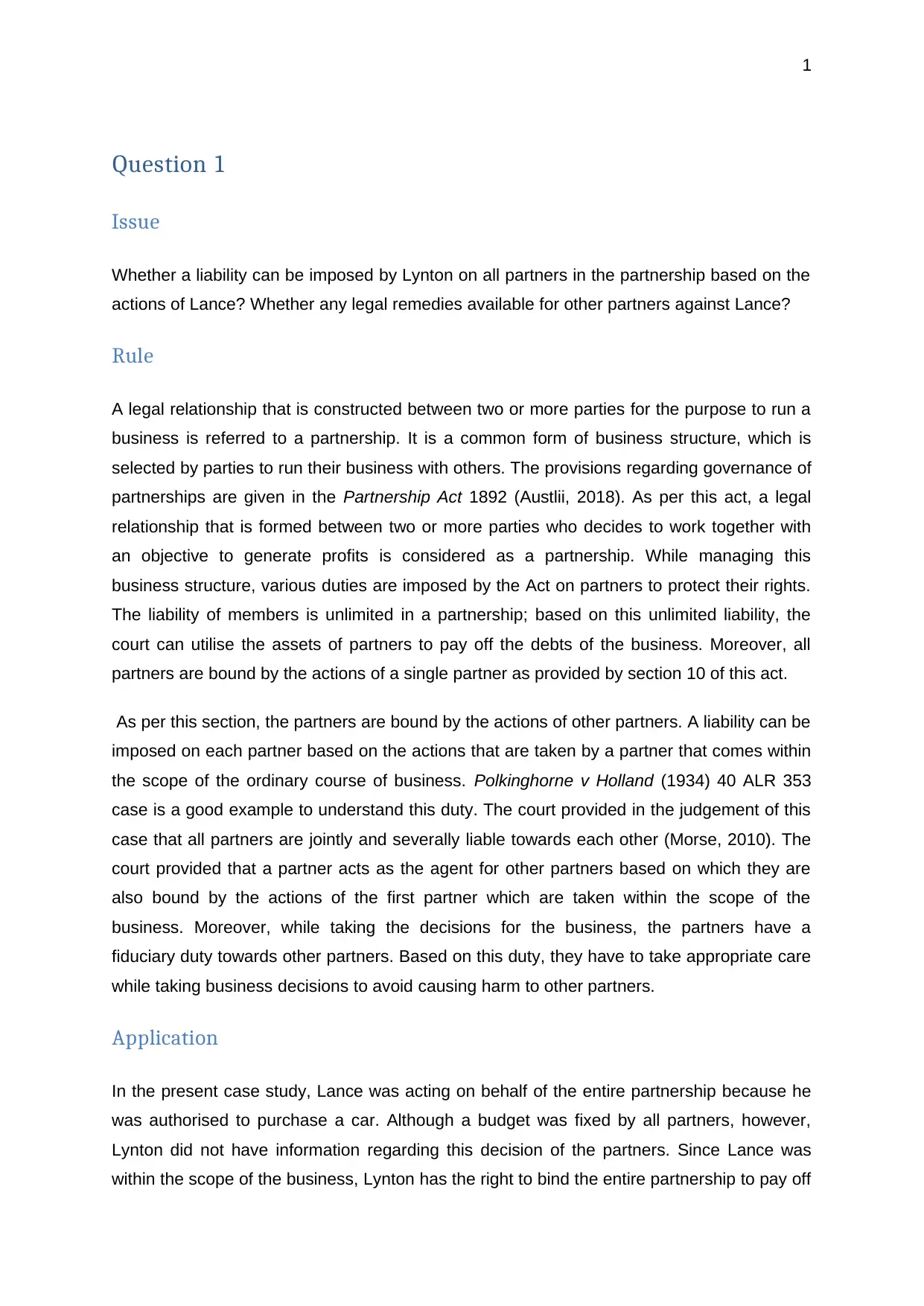
1
Question 1
Issue
Whether a liability can be imposed by Lynton on all partners in the partnership based on the
actions of Lance? Whether any legal remedies available for other partners against Lance?
Rule
A legal relationship that is constructed between two or more parties for the purpose to run a
business is referred to a partnership. It is a common form of business structure, which is
selected by parties to run their business with others. The provisions regarding governance of
partnerships are given in the Partnership Act 1892 (Austlii, 2018). As per this act, a legal
relationship that is formed between two or more parties who decides to work together with
an objective to generate profits is considered as a partnership. While managing this
business structure, various duties are imposed by the Act on partners to protect their rights.
The liability of members is unlimited in a partnership; based on this unlimited liability, the
court can utilise the assets of partners to pay off the debts of the business. Moreover, all
partners are bound by the actions of a single partner as provided by section 10 of this act.
As per this section, the partners are bound by the actions of other partners. A liability can be
imposed on each partner based on the actions that are taken by a partner that comes within
the scope of the ordinary course of business. Polkinghorne v Holland (1934) 40 ALR 353
case is a good example to understand this duty. The court provided in the judgement of this
case that all partners are jointly and severally liable towards each other (Morse, 2010). The
court provided that a partner acts as the agent for other partners based on which they are
also bound by the actions of the first partner which are taken within the scope of the
business. Moreover, while taking the decisions for the business, the partners have a
fiduciary duty towards other partners. Based on this duty, they have to take appropriate care
while taking business decisions to avoid causing harm to other partners.
Application
In the present case study, Lance was acting on behalf of the entire partnership because he
was authorised to purchase a car. Although a budget was fixed by all partners, however,
Lynton did not have information regarding this decision of the partners. Since Lance was
within the scope of the business, Lynton has the right to bind the entire partnership to pay off
Question 1
Issue
Whether a liability can be imposed by Lynton on all partners in the partnership based on the
actions of Lance? Whether any legal remedies available for other partners against Lance?
Rule
A legal relationship that is constructed between two or more parties for the purpose to run a
business is referred to a partnership. It is a common form of business structure, which is
selected by parties to run their business with others. The provisions regarding governance of
partnerships are given in the Partnership Act 1892 (Austlii, 2018). As per this act, a legal
relationship that is formed between two or more parties who decides to work together with
an objective to generate profits is considered as a partnership. While managing this
business structure, various duties are imposed by the Act on partners to protect their rights.
The liability of members is unlimited in a partnership; based on this unlimited liability, the
court can utilise the assets of partners to pay off the debts of the business. Moreover, all
partners are bound by the actions of a single partner as provided by section 10 of this act.
As per this section, the partners are bound by the actions of other partners. A liability can be
imposed on each partner based on the actions that are taken by a partner that comes within
the scope of the ordinary course of business. Polkinghorne v Holland (1934) 40 ALR 353
case is a good example to understand this duty. The court provided in the judgement of this
case that all partners are jointly and severally liable towards each other (Morse, 2010). The
court provided that a partner acts as the agent for other partners based on which they are
also bound by the actions of the first partner which are taken within the scope of the
business. Moreover, while taking the decisions for the business, the partners have a
fiduciary duty towards other partners. Based on this duty, they have to take appropriate care
while taking business decisions to avoid causing harm to other partners.
Application
In the present case study, Lance was acting on behalf of the entire partnership because he
was authorised to purchase a car. Although a budget was fixed by all partners, however,
Lynton did not have information regarding this decision of the partners. Since Lance was
within the scope of the business, Lynton has the right to bind the entire partnership to pay off
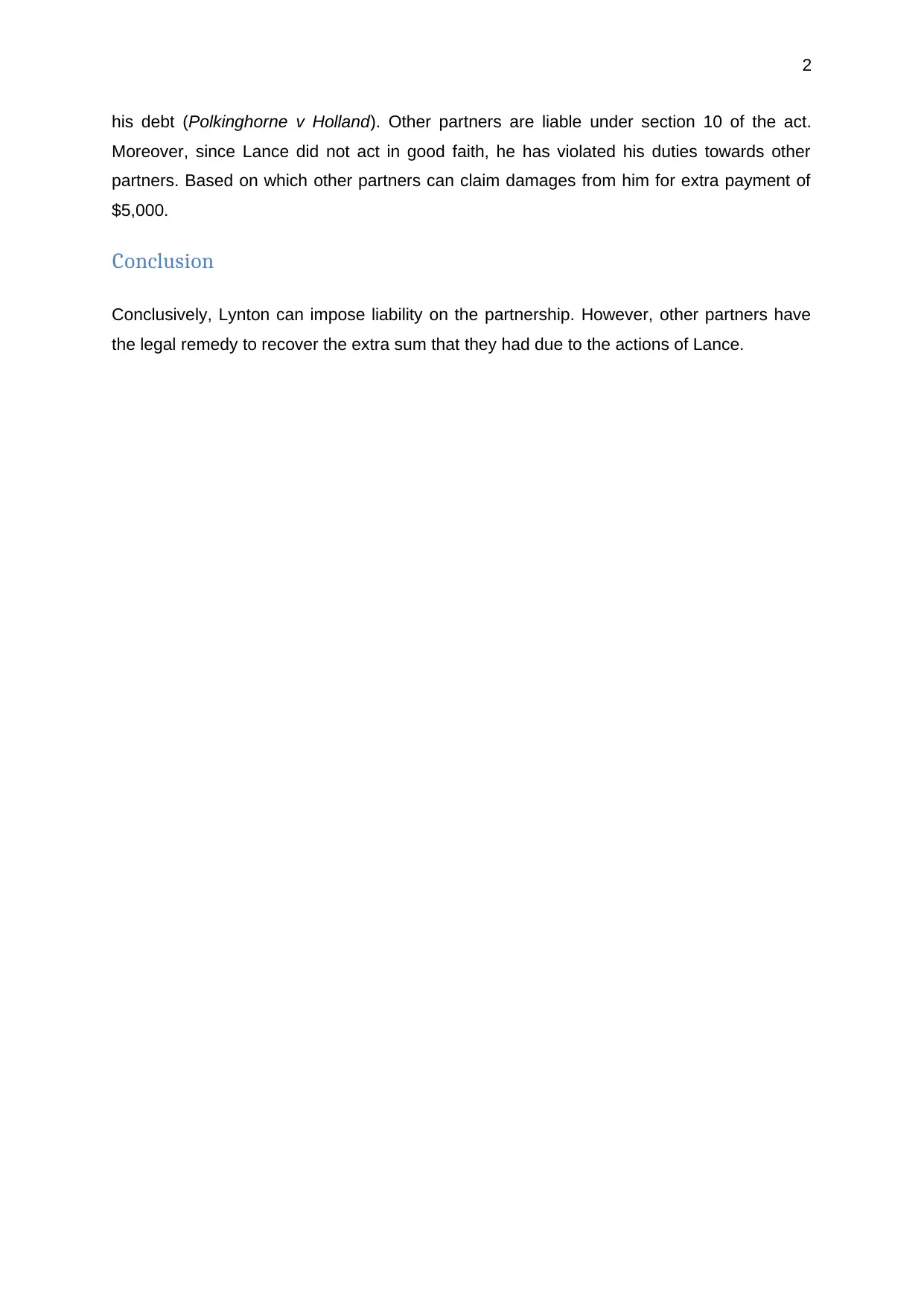
2
his debt (Polkinghorne v Holland). Other partners are liable under section 10 of the act.
Moreover, since Lance did not act in good faith, he has violated his duties towards other
partners. Based on which other partners can claim damages from him for extra payment of
$5,000.
Conclusion
Conclusively, Lynton can impose liability on the partnership. However, other partners have
the legal remedy to recover the extra sum that they had due to the actions of Lance.
his debt (Polkinghorne v Holland). Other partners are liable under section 10 of the act.
Moreover, since Lance did not act in good faith, he has violated his duties towards other
partners. Based on which other partners can claim damages from him for extra payment of
$5,000.
Conclusion
Conclusively, Lynton can impose liability on the partnership. However, other partners have
the legal remedy to recover the extra sum that they had due to the actions of Lance.
⊘ This is a preview!⊘
Do you want full access?
Subscribe today to unlock all pages.

Trusted by 1+ million students worldwide
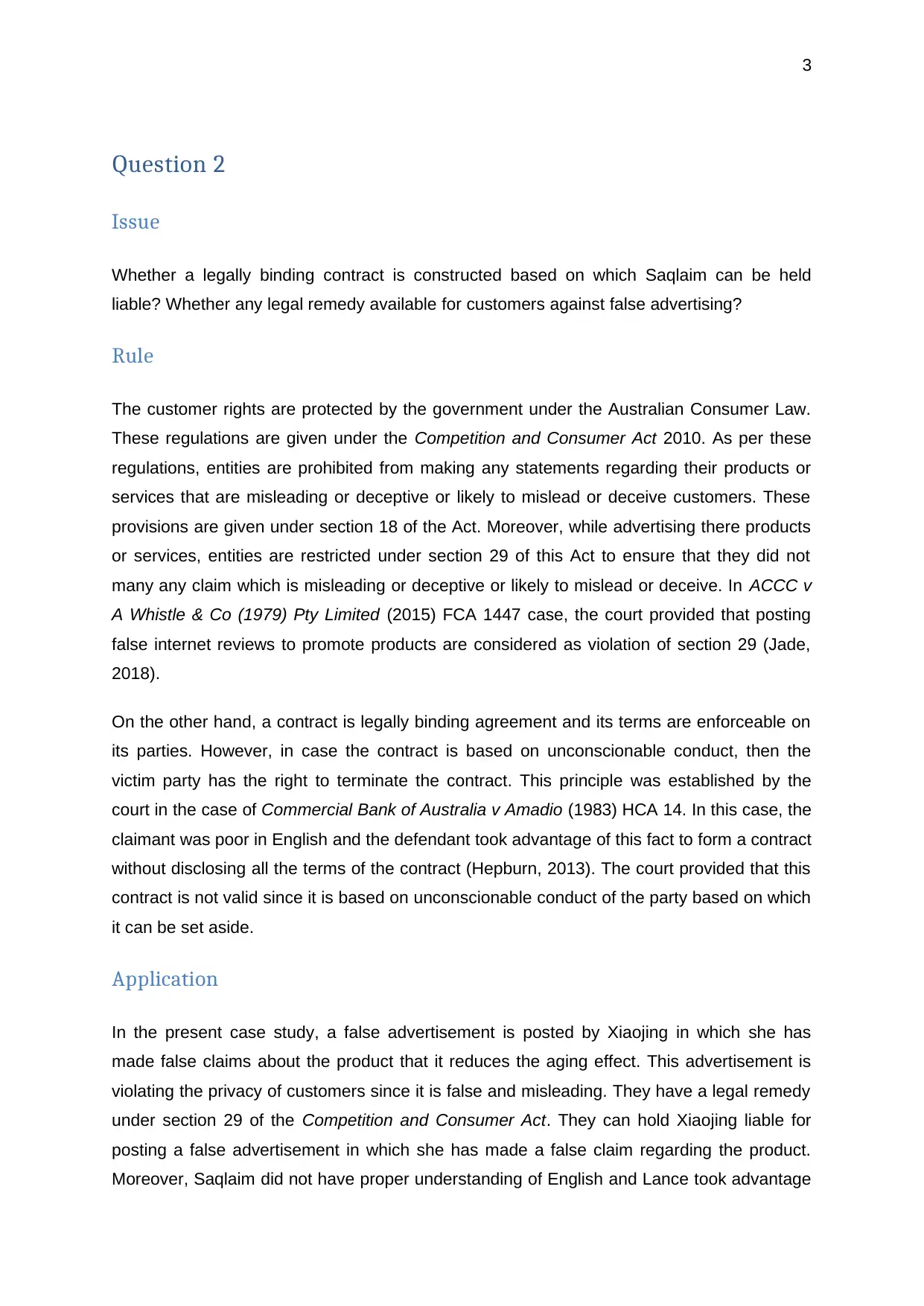
3
Question 2
Issue
Whether a legally binding contract is constructed based on which Saqlaim can be held
liable? Whether any legal remedy available for customers against false advertising?
Rule
The customer rights are protected by the government under the Australian Consumer Law.
These regulations are given under the Competition and Consumer Act 2010. As per these
regulations, entities are prohibited from making any statements regarding their products or
services that are misleading or deceptive or likely to mislead or deceive customers. These
provisions are given under section 18 of the Act. Moreover, while advertising there products
or services, entities are restricted under section 29 of this Act to ensure that they did not
many any claim which is misleading or deceptive or likely to mislead or deceive. In ACCC v
A Whistle & Co (1979) Pty Limited (2015) FCA 1447 case, the court provided that posting
false internet reviews to promote products are considered as violation of section 29 (Jade,
2018).
On the other hand, a contract is legally binding agreement and its terms are enforceable on
its parties. However, in case the contract is based on unconscionable conduct, then the
victim party has the right to terminate the contract. This principle was established by the
court in the case of Commercial Bank of Australia v Amadio (1983) HCA 14. In this case, the
claimant was poor in English and the defendant took advantage of this fact to form a contract
without disclosing all the terms of the contract (Hepburn, 2013). The court provided that this
contract is not valid since it is based on unconscionable conduct of the party based on which
it can be set aside.
Application
In the present case study, a false advertisement is posted by Xiaojing in which she has
made false claims about the product that it reduces the aging effect. This advertisement is
violating the privacy of customers since it is false and misleading. They have a legal remedy
under section 29 of the Competition and Consumer Act. They can hold Xiaojing liable for
posting a false advertisement in which she has made a false claim regarding the product.
Moreover, Saqlaim did not have proper understanding of English and Lance took advantage
Question 2
Issue
Whether a legally binding contract is constructed based on which Saqlaim can be held
liable? Whether any legal remedy available for customers against false advertising?
Rule
The customer rights are protected by the government under the Australian Consumer Law.
These regulations are given under the Competition and Consumer Act 2010. As per these
regulations, entities are prohibited from making any statements regarding their products or
services that are misleading or deceptive or likely to mislead or deceive customers. These
provisions are given under section 18 of the Act. Moreover, while advertising there products
or services, entities are restricted under section 29 of this Act to ensure that they did not
many any claim which is misleading or deceptive or likely to mislead or deceive. In ACCC v
A Whistle & Co (1979) Pty Limited (2015) FCA 1447 case, the court provided that posting
false internet reviews to promote products are considered as violation of section 29 (Jade,
2018).
On the other hand, a contract is legally binding agreement and its terms are enforceable on
its parties. However, in case the contract is based on unconscionable conduct, then the
victim party has the right to terminate the contract. This principle was established by the
court in the case of Commercial Bank of Australia v Amadio (1983) HCA 14. In this case, the
claimant was poor in English and the defendant took advantage of this fact to form a contract
without disclosing all the terms of the contract (Hepburn, 2013). The court provided that this
contract is not valid since it is based on unconscionable conduct of the party based on which
it can be set aside.
Application
In the present case study, a false advertisement is posted by Xiaojing in which she has
made false claims about the product that it reduces the aging effect. This advertisement is
violating the privacy of customers since it is false and misleading. They have a legal remedy
under section 29 of the Competition and Consumer Act. They can hold Xiaojing liable for
posting a false advertisement in which she has made a false claim regarding the product.
Moreover, Saqlaim did not have proper understanding of English and Lance took advantage
Paraphrase This Document
Need a fresh take? Get an instant paraphrase of this document with our AI Paraphraser
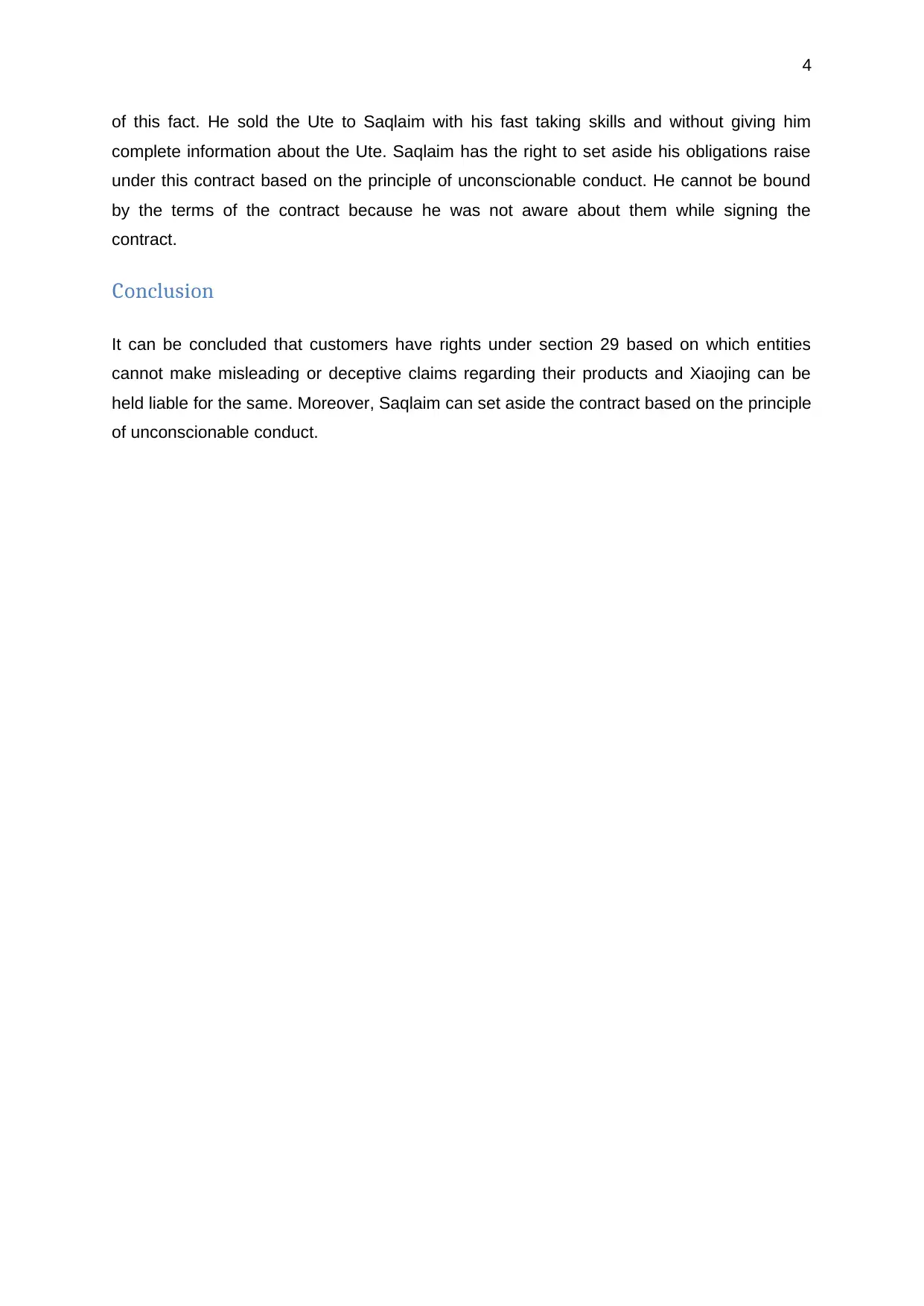
4
of this fact. He sold the Ute to Saqlaim with his fast taking skills and without giving him
complete information about the Ute. Saqlaim has the right to set aside his obligations raise
under this contract based on the principle of unconscionable conduct. He cannot be bound
by the terms of the contract because he was not aware about them while signing the
contract.
Conclusion
It can be concluded that customers have rights under section 29 based on which entities
cannot make misleading or deceptive claims regarding their products and Xiaojing can be
held liable for the same. Moreover, Saqlaim can set aside the contract based on the principle
of unconscionable conduct.
of this fact. He sold the Ute to Saqlaim with his fast taking skills and without giving him
complete information about the Ute. Saqlaim has the right to set aside his obligations raise
under this contract based on the principle of unconscionable conduct. He cannot be bound
by the terms of the contract because he was not aware about them while signing the
contract.
Conclusion
It can be concluded that customers have rights under section 29 based on which entities
cannot make misleading or deceptive claims regarding their products and Xiaojing can be
held liable for the same. Moreover, Saqlaim can set aside the contract based on the principle
of unconscionable conduct.
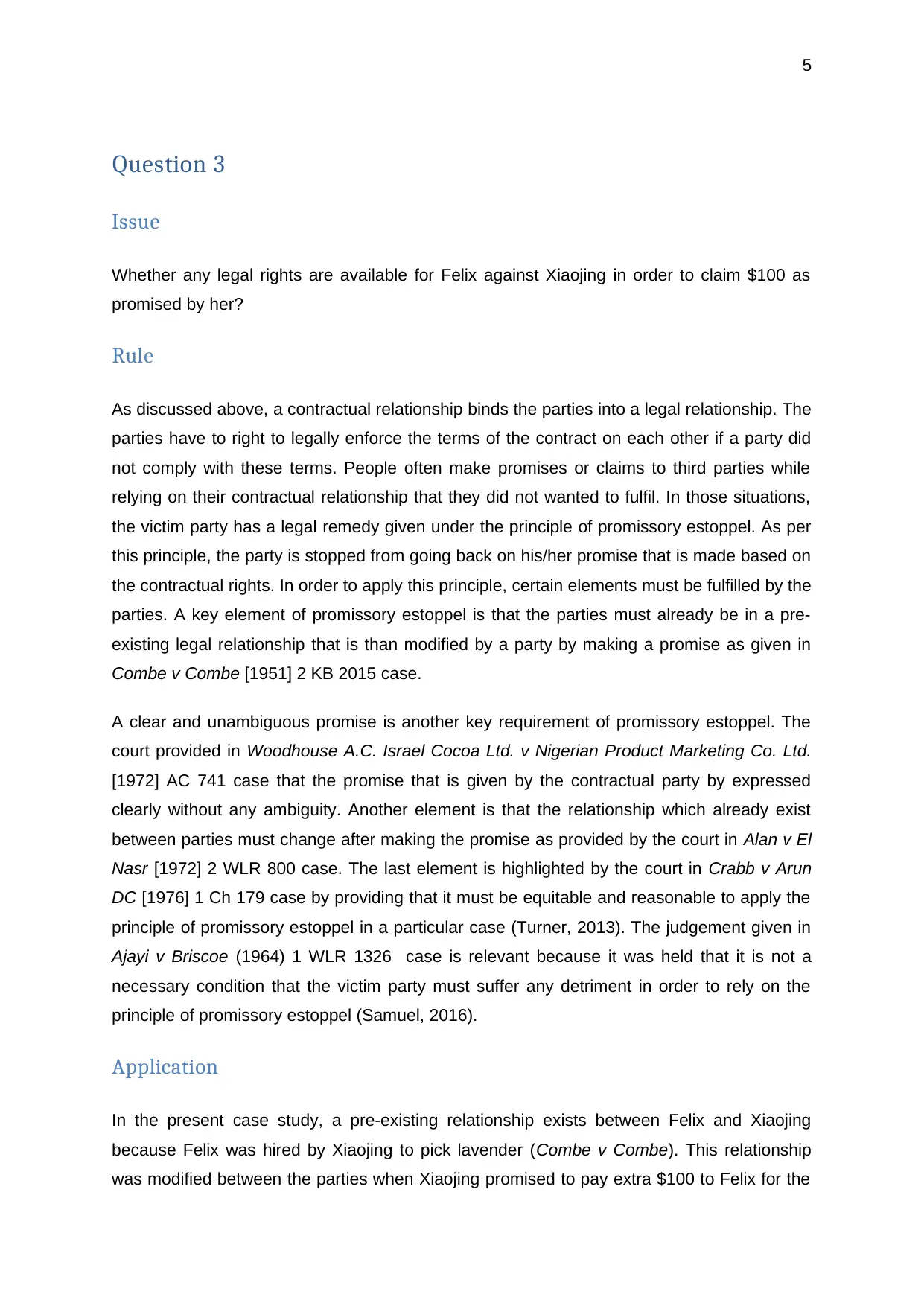
5
Question 3
Issue
Whether any legal rights are available for Felix against Xiaojing in order to claim $100 as
promised by her?
Rule
As discussed above, a contractual relationship binds the parties into a legal relationship. The
parties have to right to legally enforce the terms of the contract on each other if a party did
not comply with these terms. People often make promises or claims to third parties while
relying on their contractual relationship that they did not wanted to fulfil. In those situations,
the victim party has a legal remedy given under the principle of promissory estoppel. As per
this principle, the party is stopped from going back on his/her promise that is made based on
the contractual rights. In order to apply this principle, certain elements must be fulfilled by the
parties. A key element of promissory estoppel is that the parties must already be in a pre-
existing legal relationship that is than modified by a party by making a promise as given in
Combe v Combe [1951] 2 KB 2015 case.
A clear and unambiguous promise is another key requirement of promissory estoppel. The
court provided in Woodhouse A.C. Israel Cocoa Ltd. v Nigerian Product Marketing Co. Ltd.
[1972] AC 741 case that the promise that is given by the contractual party by expressed
clearly without any ambiguity. Another element is that the relationship which already exist
between parties must change after making the promise as provided by the court in Alan v El
Nasr [1972] 2 WLR 800 case. The last element is highlighted by the court in Crabb v Arun
DC [1976] 1 Ch 179 case by providing that it must be equitable and reasonable to apply the
principle of promissory estoppel in a particular case (Turner, 2013). The judgement given in
Ajayi v Briscoe (1964) 1 WLR 1326 case is relevant because it was held that it is not a
necessary condition that the victim party must suffer any detriment in order to rely on the
principle of promissory estoppel (Samuel, 2016).
Application
In the present case study, a pre-existing relationship exists between Felix and Xiaojing
because Felix was hired by Xiaojing to pick lavender (Combe v Combe). This relationship
was modified between the parties when Xiaojing promised to pay extra $100 to Felix for the
Question 3
Issue
Whether any legal rights are available for Felix against Xiaojing in order to claim $100 as
promised by her?
Rule
As discussed above, a contractual relationship binds the parties into a legal relationship. The
parties have to right to legally enforce the terms of the contract on each other if a party did
not comply with these terms. People often make promises or claims to third parties while
relying on their contractual relationship that they did not wanted to fulfil. In those situations,
the victim party has a legal remedy given under the principle of promissory estoppel. As per
this principle, the party is stopped from going back on his/her promise that is made based on
the contractual rights. In order to apply this principle, certain elements must be fulfilled by the
parties. A key element of promissory estoppel is that the parties must already be in a pre-
existing legal relationship that is than modified by a party by making a promise as given in
Combe v Combe [1951] 2 KB 2015 case.
A clear and unambiguous promise is another key requirement of promissory estoppel. The
court provided in Woodhouse A.C. Israel Cocoa Ltd. v Nigerian Product Marketing Co. Ltd.
[1972] AC 741 case that the promise that is given by the contractual party by expressed
clearly without any ambiguity. Another element is that the relationship which already exist
between parties must change after making the promise as provided by the court in Alan v El
Nasr [1972] 2 WLR 800 case. The last element is highlighted by the court in Crabb v Arun
DC [1976] 1 Ch 179 case by providing that it must be equitable and reasonable to apply the
principle of promissory estoppel in a particular case (Turner, 2013). The judgement given in
Ajayi v Briscoe (1964) 1 WLR 1326 case is relevant because it was held that it is not a
necessary condition that the victim party must suffer any detriment in order to rely on the
principle of promissory estoppel (Samuel, 2016).
Application
In the present case study, a pre-existing relationship exists between Felix and Xiaojing
because Felix was hired by Xiaojing to pick lavender (Combe v Combe). This relationship
was modified between the parties when Xiaojing promised to pay extra $100 to Felix for the
⊘ This is a preview!⊘
Do you want full access?
Subscribe today to unlock all pages.

Trusted by 1+ million students worldwide
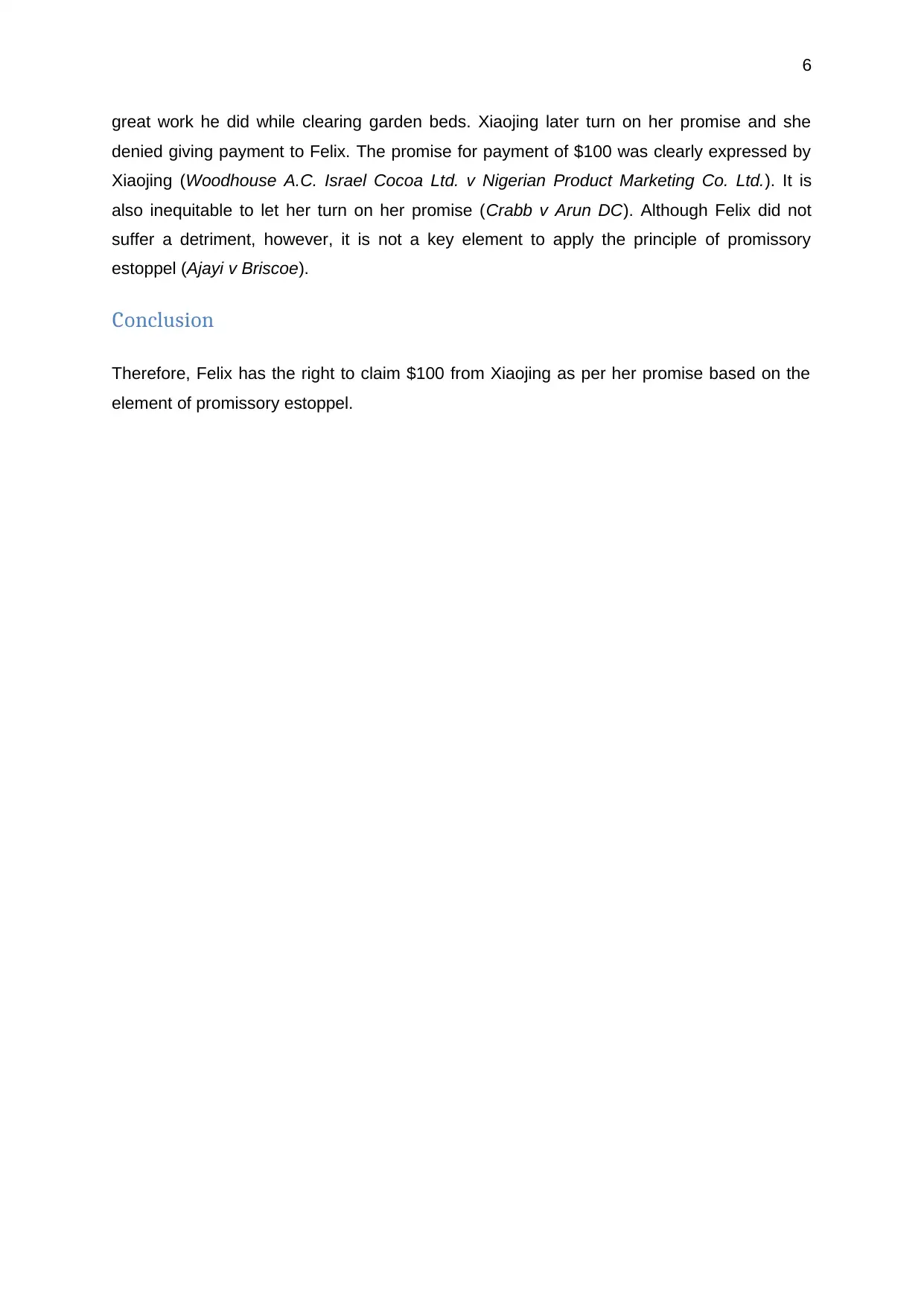
6
great work he did while clearing garden beds. Xiaojing later turn on her promise and she
denied giving payment to Felix. The promise for payment of $100 was clearly expressed by
Xiaojing (Woodhouse A.C. Israel Cocoa Ltd. v Nigerian Product Marketing Co. Ltd.). It is
also inequitable to let her turn on her promise (Crabb v Arun DC). Although Felix did not
suffer a detriment, however, it is not a key element to apply the principle of promissory
estoppel (Ajayi v Briscoe).
Conclusion
Therefore, Felix has the right to claim $100 from Xiaojing as per her promise based on the
element of promissory estoppel.
great work he did while clearing garden beds. Xiaojing later turn on her promise and she
denied giving payment to Felix. The promise for payment of $100 was clearly expressed by
Xiaojing (Woodhouse A.C. Israel Cocoa Ltd. v Nigerian Product Marketing Co. Ltd.). It is
also inequitable to let her turn on her promise (Crabb v Arun DC). Although Felix did not
suffer a detriment, however, it is not a key element to apply the principle of promissory
estoppel (Ajayi v Briscoe).
Conclusion
Therefore, Felix has the right to claim $100 from Xiaojing as per her promise based on the
element of promissory estoppel.
Paraphrase This Document
Need a fresh take? Get an instant paraphrase of this document with our AI Paraphraser
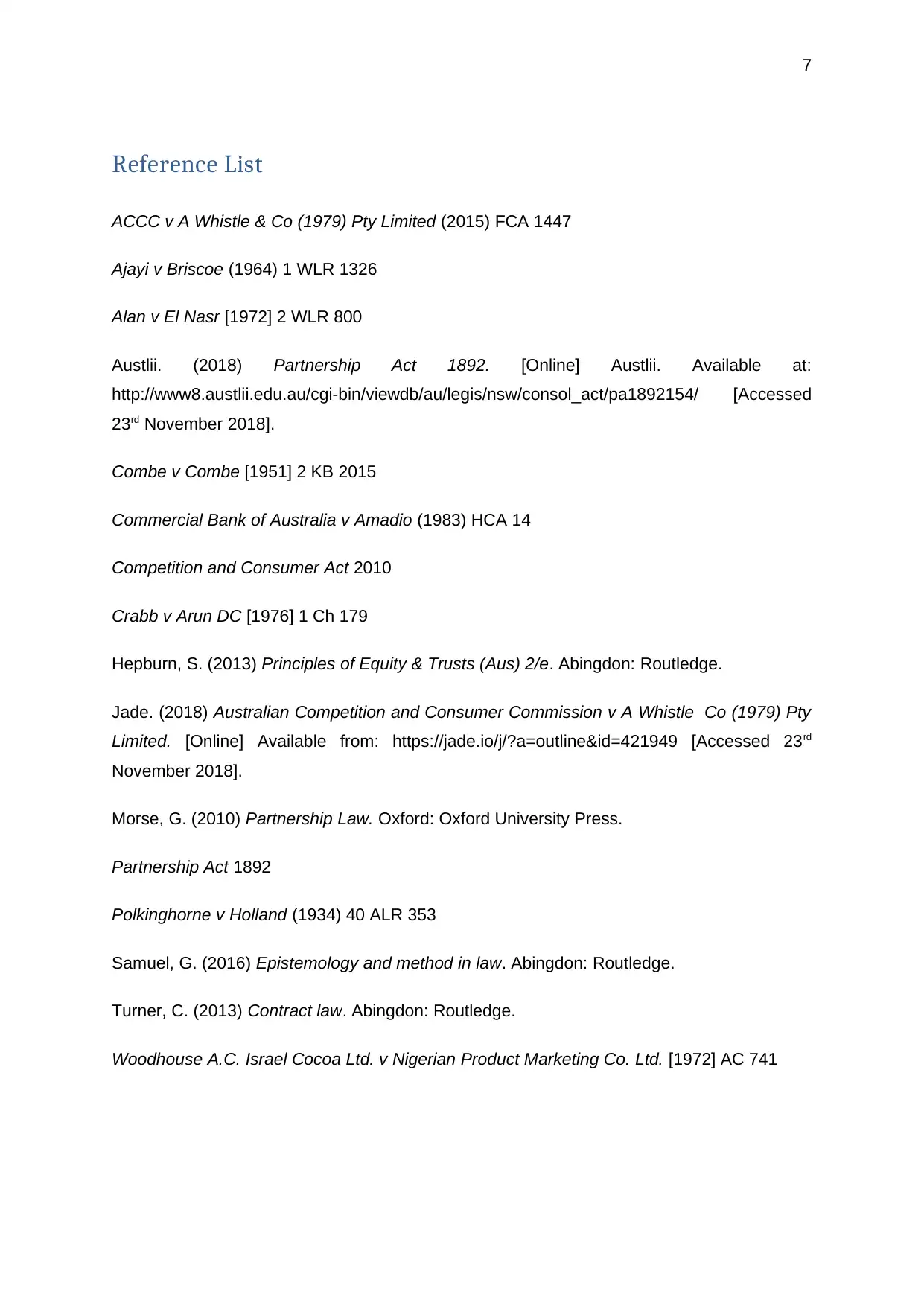
7
Reference List
ACCC v A Whistle & Co (1979) Pty Limited (2015) FCA 1447
Ajayi v Briscoe (1964) 1 WLR 1326
Alan v El Nasr [1972] 2 WLR 800
Austlii. (2018) Partnership Act 1892. [Online] Austlii. Available at:
http://www8.austlii.edu.au/cgi-bin/viewdb/au/legis/nsw/consol_act/pa1892154/ [Accessed
23rd November 2018].
Combe v Combe [1951] 2 KB 2015
Commercial Bank of Australia v Amadio (1983) HCA 14
Competition and Consumer Act 2010
Crabb v Arun DC [1976] 1 Ch 179
Hepburn, S. (2013) Principles of Equity & Trusts (Aus) 2/e. Abingdon: Routledge.
Jade. (2018) Australian Competition and Consumer Commission v A Whistle Co (1979) Pty
Limited. [Online] Available from: https://jade.io/j/?a=outline&id=421949 [Accessed 23rd
November 2018].
Morse, G. (2010) Partnership Law. Oxford: Oxford University Press.
Partnership Act 1892
Polkinghorne v Holland (1934) 40 ALR 353
Samuel, G. (2016) Epistemology and method in law. Abingdon: Routledge.
Turner, C. (2013) Contract law. Abingdon: Routledge.
Woodhouse A.C. Israel Cocoa Ltd. v Nigerian Product Marketing Co. Ltd. [1972] AC 741
Reference List
ACCC v A Whistle & Co (1979) Pty Limited (2015) FCA 1447
Ajayi v Briscoe (1964) 1 WLR 1326
Alan v El Nasr [1972] 2 WLR 800
Austlii. (2018) Partnership Act 1892. [Online] Austlii. Available at:
http://www8.austlii.edu.au/cgi-bin/viewdb/au/legis/nsw/consol_act/pa1892154/ [Accessed
23rd November 2018].
Combe v Combe [1951] 2 KB 2015
Commercial Bank of Australia v Amadio (1983) HCA 14
Competition and Consumer Act 2010
Crabb v Arun DC [1976] 1 Ch 179
Hepburn, S. (2013) Principles of Equity & Trusts (Aus) 2/e. Abingdon: Routledge.
Jade. (2018) Australian Competition and Consumer Commission v A Whistle Co (1979) Pty
Limited. [Online] Available from: https://jade.io/j/?a=outline&id=421949 [Accessed 23rd
November 2018].
Morse, G. (2010) Partnership Law. Oxford: Oxford University Press.
Partnership Act 1892
Polkinghorne v Holland (1934) 40 ALR 353
Samuel, G. (2016) Epistemology and method in law. Abingdon: Routledge.
Turner, C. (2013) Contract law. Abingdon: Routledge.
Woodhouse A.C. Israel Cocoa Ltd. v Nigerian Product Marketing Co. Ltd. [1972] AC 741
1 out of 8
Related Documents
Your All-in-One AI-Powered Toolkit for Academic Success.
+13062052269
info@desklib.com
Available 24*7 on WhatsApp / Email
![[object Object]](/_next/static/media/star-bottom.7253800d.svg)
Unlock your academic potential
Copyright © 2020–2025 A2Z Services. All Rights Reserved. Developed and managed by ZUCOL.



